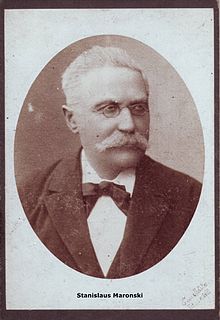Stanislaus Maronski
Stanislaus Maronski (born April 30, 1825 in Gnesen ; † February 12, 1907 in Hohensalza ) was a high school teacher in Polish history.
Life
Stanislaus Maronski (Stanisław Maroński) was brought up conservatively Catholic in the sense of his Polish ethnic affiliation. His parents sent him to the Tresmessen high school in the Grand Duchy of Poznan in 1840 . After receiving the certificate of maturity, he enrolled at the University of Wroclaw in 1847 , where he mainly attended historical, geographical, philological and philosophical lectures. In 1854 he underwent the oral examination pro facultate docendi ( teaching qualification ) before the royal scientific examination committee. After successfully completing his studies, he was awarded the unconditional facultate docendi . With the qualification to teach for higher schools, he then began his probationary year at the Gymnasium zu Culm in West Prussia , from where he switched to the Gymnasium zu Conitz as a scientific assistant teacher in 1855 . There he met his future wife Leocadia Grünfeld.
In 1857 Stanislaus Maronski was employed as the third full teacher at the newly founded Progymnasium in Neustadt in West Prussia . Her son, who died on June 26, 1857 in Neustadt i. West Prussia was born, was traditionally named after his father Stanislaus. Another four siblings followed him by 1863. When the Progymnasium was raised to a full grammar school, Stanislaus Maronski rose to the position of 2nd senior teacher. He taught Polish, history and Latin. In 1872 he applied for retirement for health reasons. After retiring, he moved to Poznan . Even after his retirement he continued his historical activity and published several books and historical essays until 1884. On September 14, 1874, his wife Leocadia died at the age of 44. She left five children. After this hard stroke of fate, M. moved with his children to Neuchâtel in West Prussia in the district of Schwetz (Vistula) the following year . However, in 1876 he moved his residence to Pelplin near Preussisch Stargard . Most recently, he lived in Hohensalza , where he died on February 12, 1907, shortly before he was 82 years old. In addition to his scientific and historical work, he devoted himself to painting in his spare time, especially portraits of well-known personalities.
Works
- Pieśń o narodzie cierpienia. Ernest Günther, Gniezno 1848, 39 pp.
- O Sottysach w Polsce (About the Schulzenamt in Poland 1851)
- De auguribus Romanis. Printed by H. Brandenburg, Neustadt in Westpreussen 1859, 26 pp.
- The family ties and political relations between Pomerania and Poland, until the end of the first Polish rule in Pomerania, in 1277. Neustadt i. W. 1866 ( Online, Google ).
- O nawrózu Pomorzan (On the conversion of the Pomeranians in 1874)
- Some linguistic-historical remarks and digressions on the occasion of Philippi's writing: “Die von der Marwitz”. Königsberg in Prussia 1880.
- Stowianie Meklemburscy (The Mecklenburg Slavs 1831)
- Rozbiór krytyczny Libri Beneficiorum Jana Laskiego (Critical Analysis of the Libri Beneficiorum by Johann Laski 1882)
- Herodot's Gelonen: no Prussian-Lithuanian nation. Danzig Publishing Company, Danzig 1883, 54 pp.
- O zatozeniu biskupswa Lebus 1883
- Obraz ekonomiczno-statystyczny Archidyecezyi Gnieznienskiéj w wieku XVI (Economic-statistical conditions of the Archdiocese of Gniezno in the XVIth century 1883), Jan Laski
- Prymas (Primate Johann Laski 1884)
literature
- Short biography of Stanislaus Maronski in The Literary Germany 1887, Verlag der Album-Stiftung (Carl Hinstorff's Verlag)
| personal data | |
|---|---|
| SURNAME | Maronski, Stanislaus |
| BRIEF DESCRIPTION | Polish historian |
| DATE OF BIRTH | April 30, 1825 |
| PLACE OF BIRTH | Gniezno |
| DATE OF DEATH | February 12, 1907 |
| Place of death | Hohensalza |
